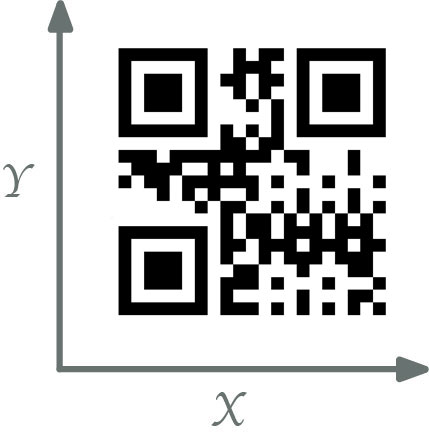Quick Response (QR) codes
QR Code
Quick Response (QR) codes are one of the most familiar and recognizable types of 2D barcodes. Originally developed in 1994 by Masahiro Hara of Japanese company Denso Wave, QR Codes were designed to track vehicle components during the production process through high-speed scanning. Now, a variety of ISO/IEC standards cover the public domain use of QR codes including ISO/IEC 18004:2000, ISO/IEC 18004:2006 and ISO/IEC 18004:2015. QR Codes are also one of the only barcode types capable of encoding Japanese Kanji and Kana characters.
QR Codes are composed of three large squares at three corners of the barcode image and a fourth smaller square — or multiple squares — in the last corner which allows the barcode reader to determine image size, orientation, and viewing angle. Small dots located throughout the barcode are converted to binary and validated using an error-correcting algorithm. QR Codes also support multiple levels for error correction, with the tradeoff that as more information can be recovered, less information can be stored. These levels are:
- Level L (Low) — 7% of data can be recovered.
- Level M (Medium) — 15% of data can be recovered.
- Level Q (Quartile) — 25% of data can be recovered.
- Level H (High) — 30% of data can be recovered.

Format
There are 40 versions of standard QR Codes, each of increasing size. Version 1 contains 21×21 modules, while version 40 contains 144×144 modules — starting from version 1, each subsequent model increases module counts in steps of 4 — 25×25 for version 2, 29×29 for version 3, etc.
The maximum numeric data capacity of a QR Code is 7080 digits, and the maximum alphanumeric capacity is 4296 characters. QR Codes can also contain 1817 Kanji characters. Micro QR Codes with sizes as small as 11×11 modules are also available for applications where space is limited.

Common Use Cases
While QR Codes were originally used to track auto manufacturing, they’re now popular in mobile advertising campaigns across the globe. The compact, clearly-defined nature of these barcodes means they’re easy to read with simple smartphone applications, making them ideal for everything from product tracking to online payments, website logins, and even augmented reality.